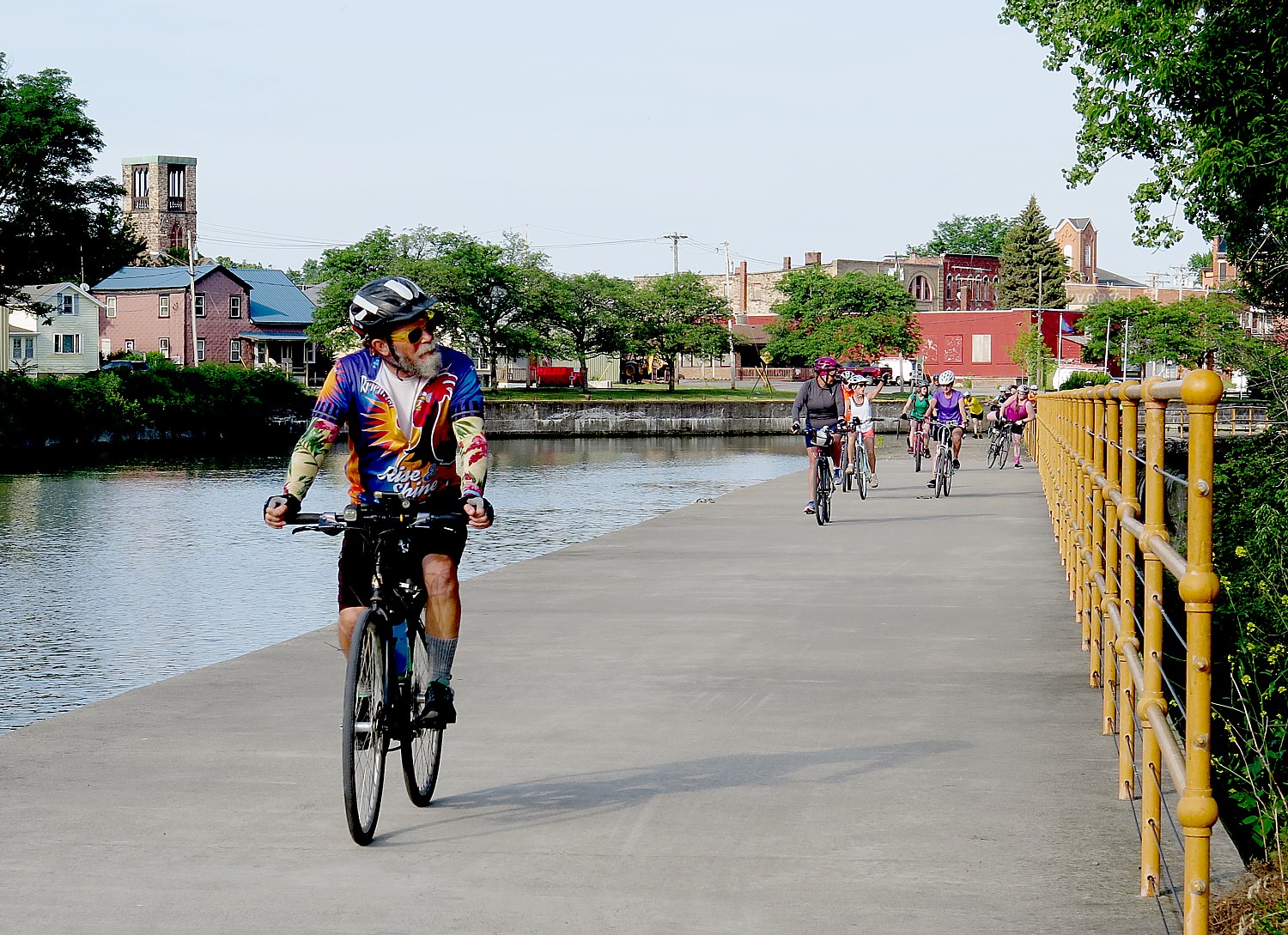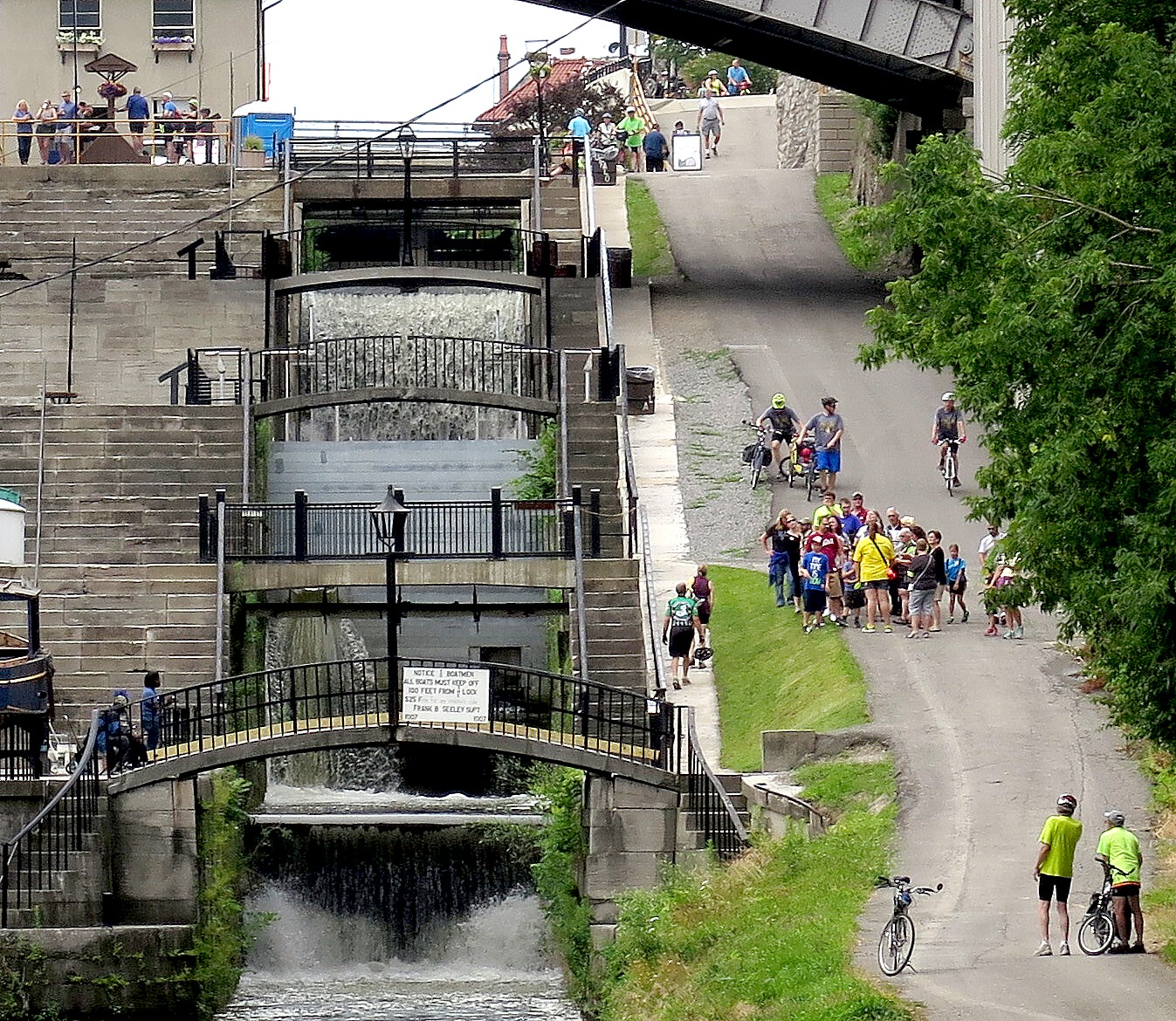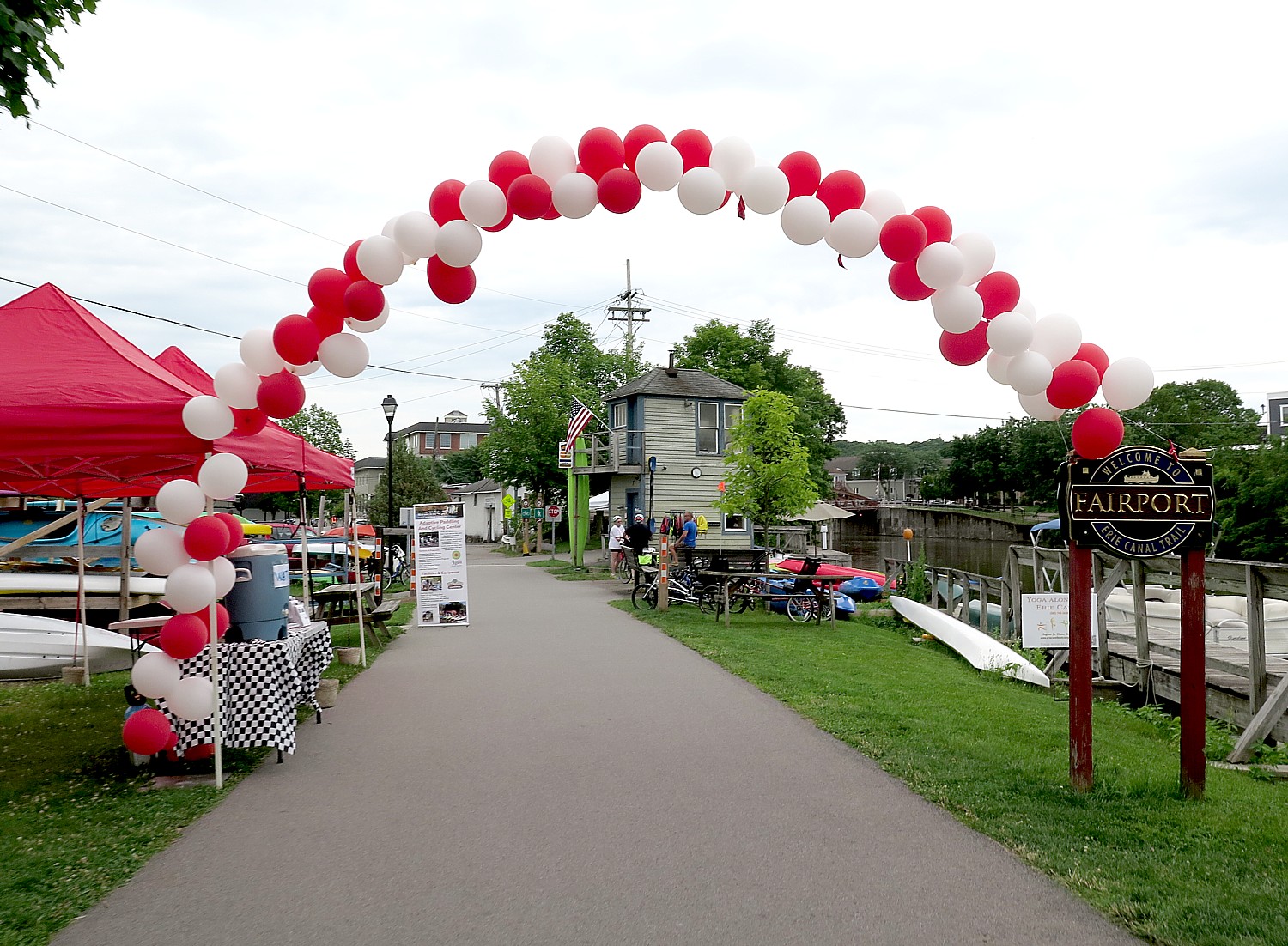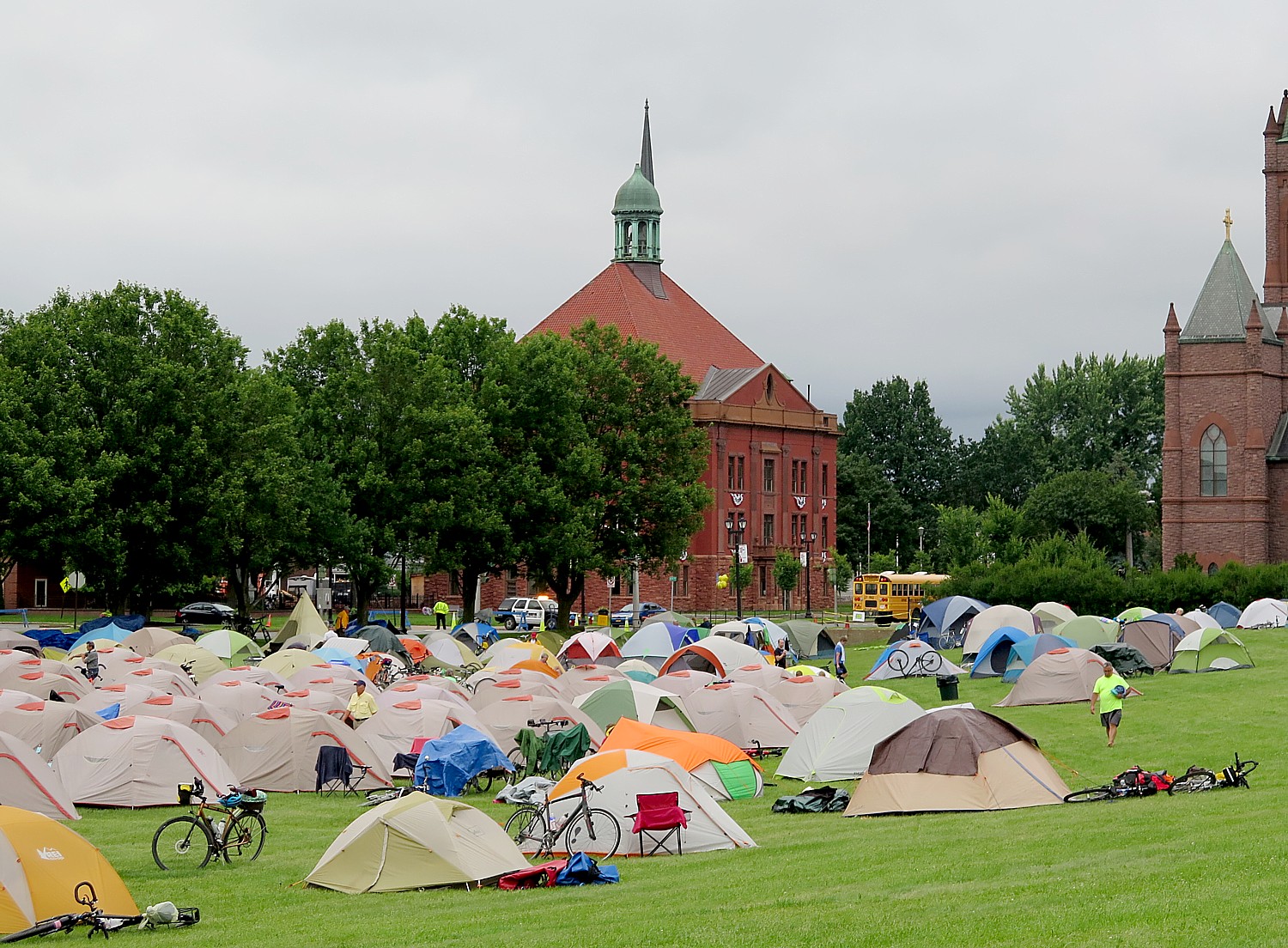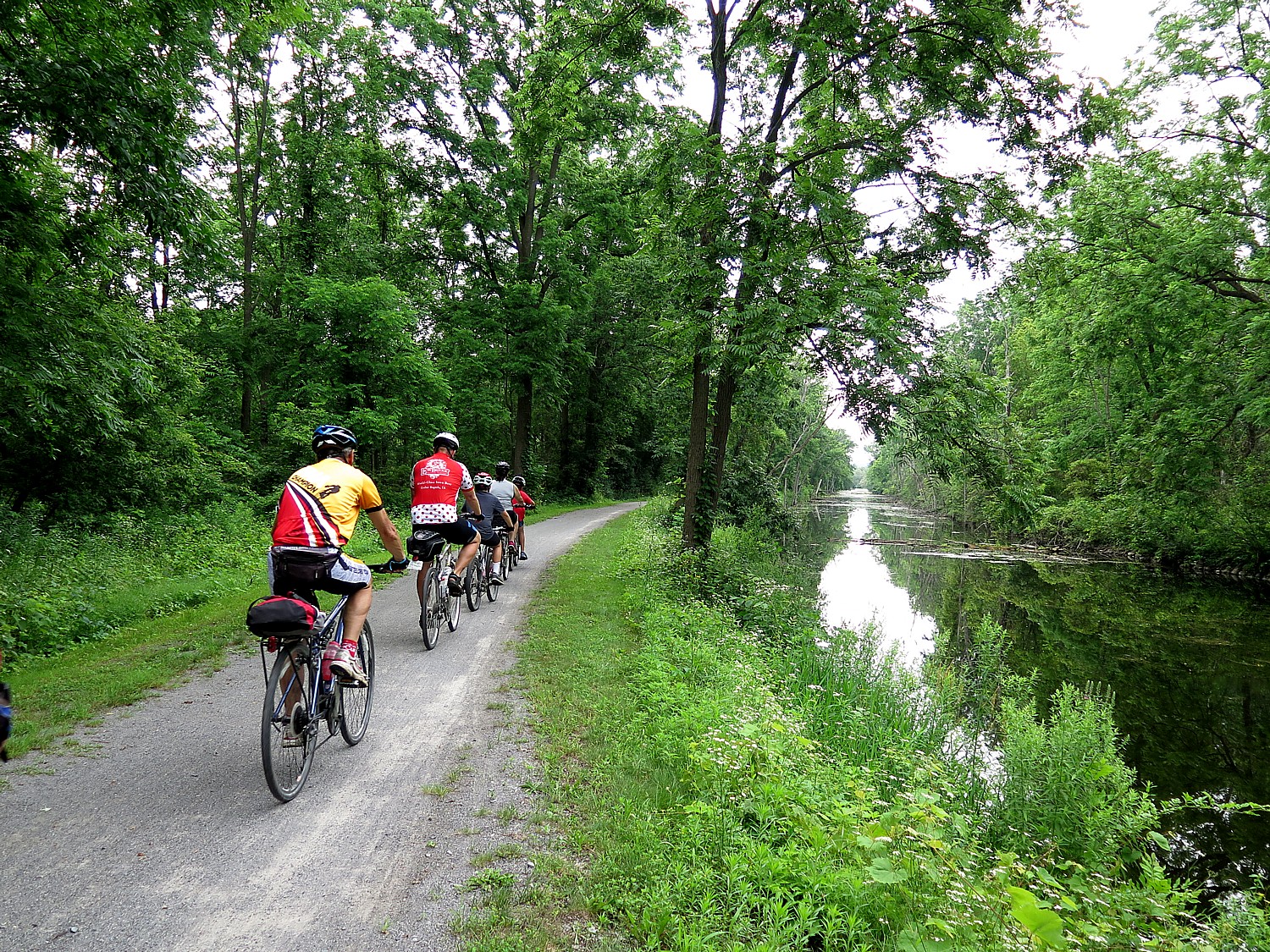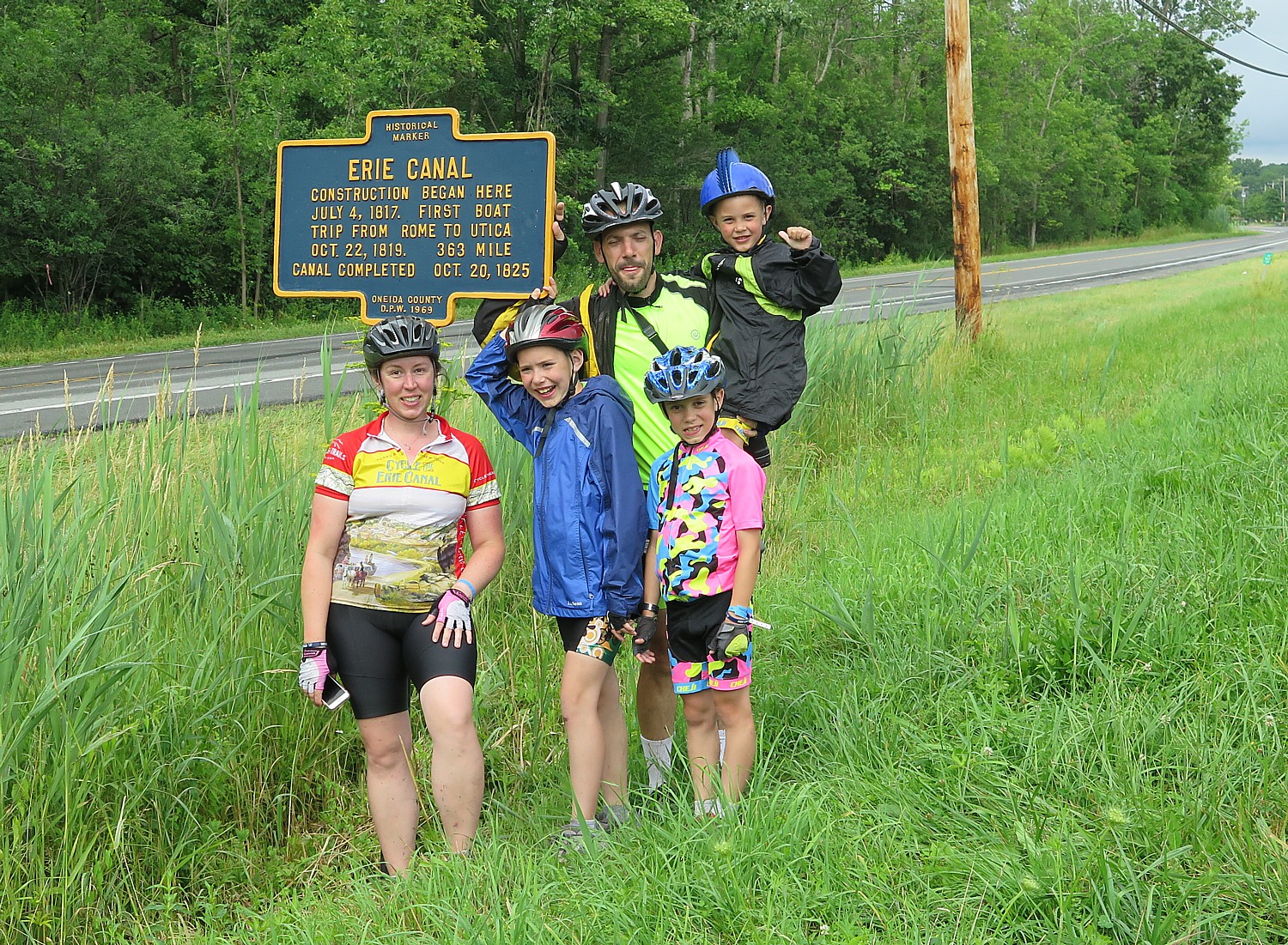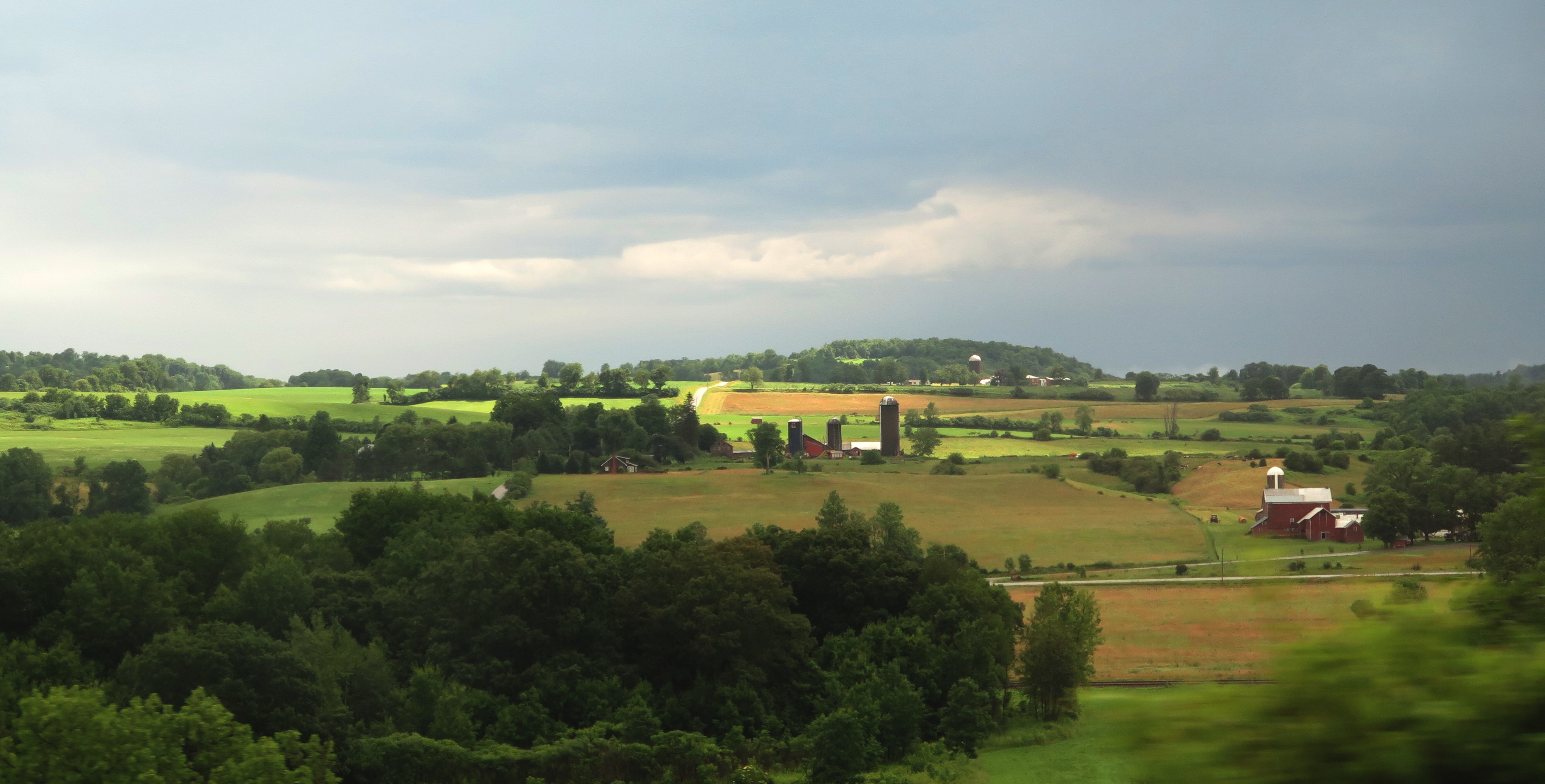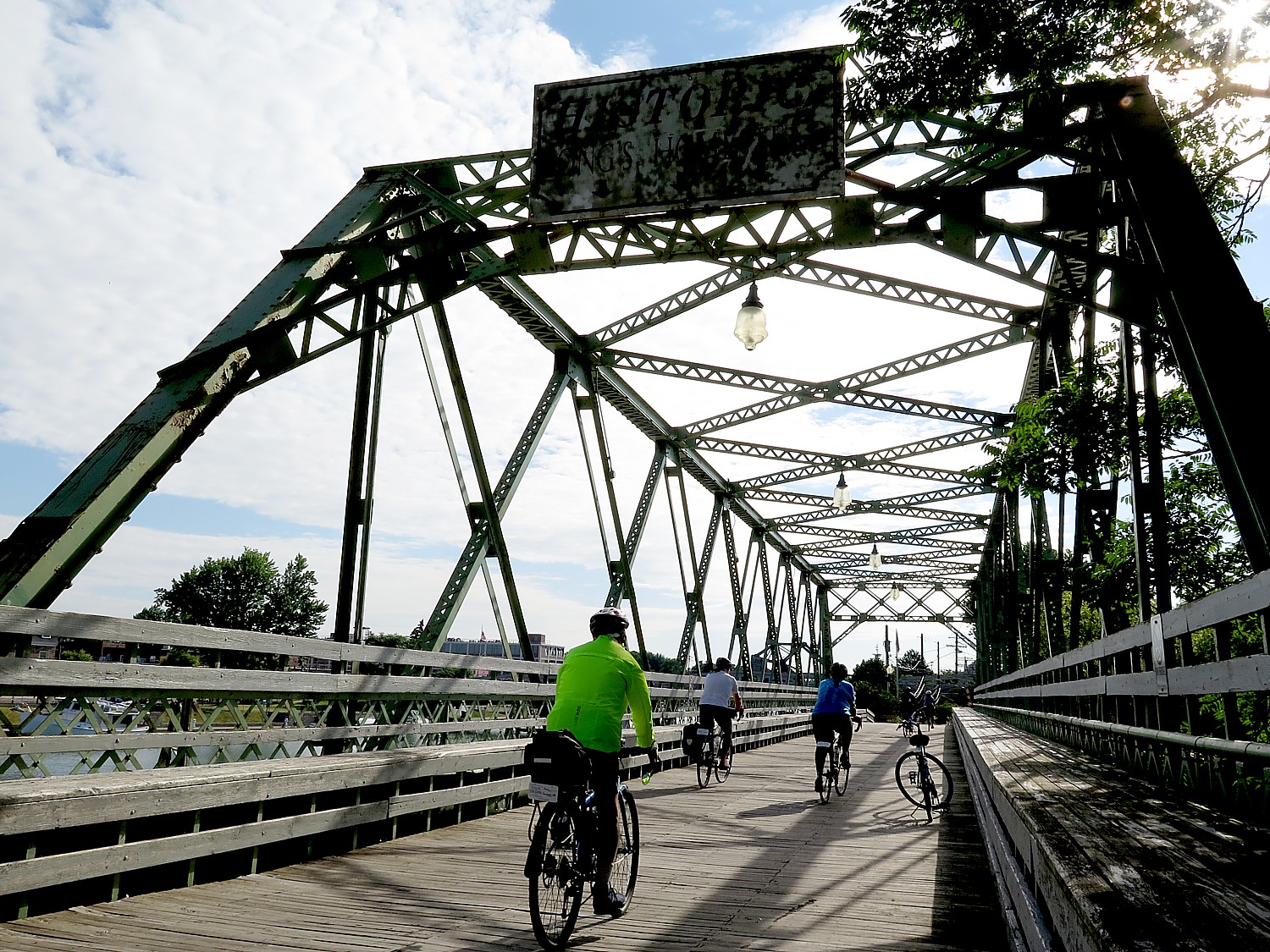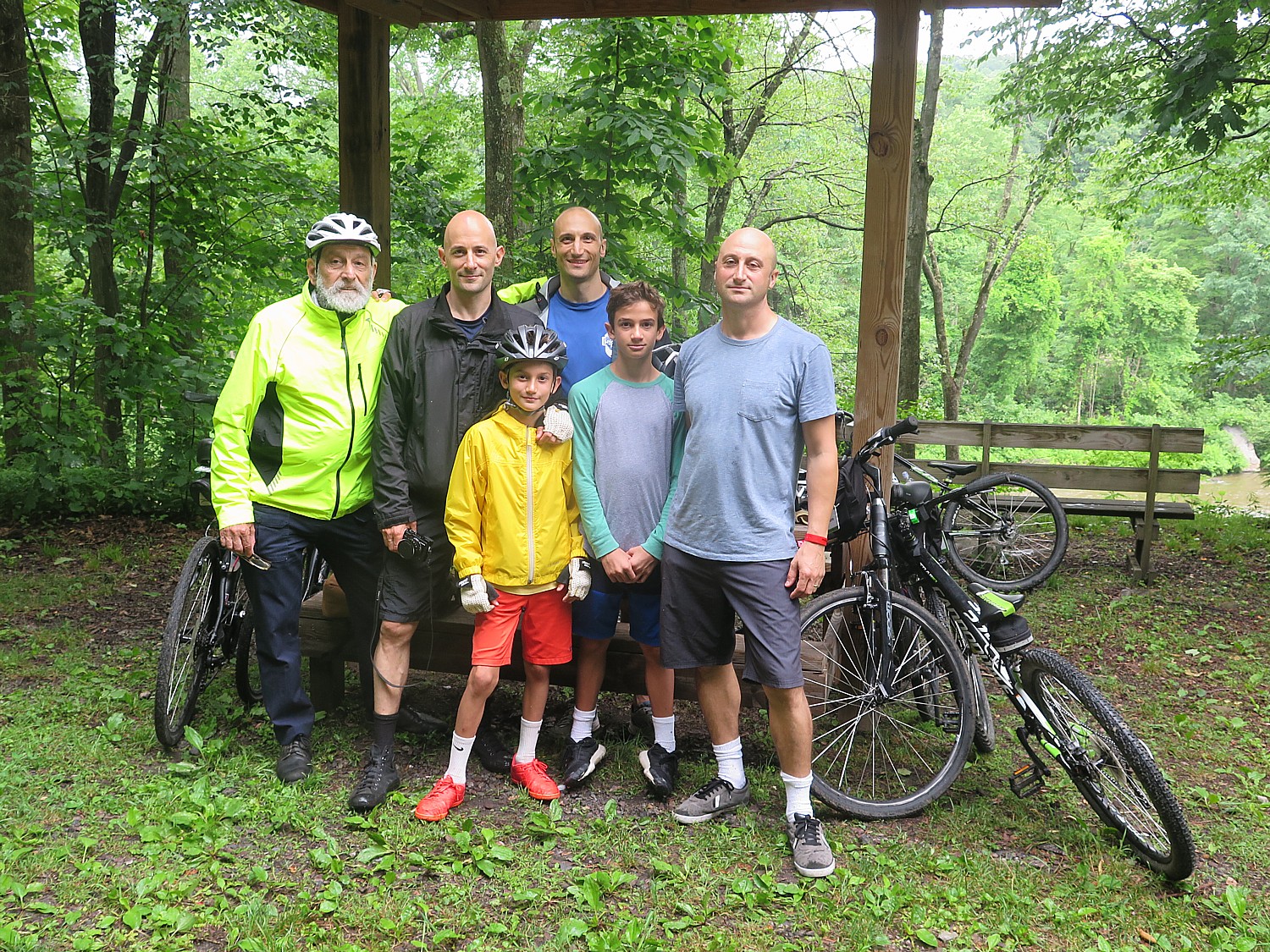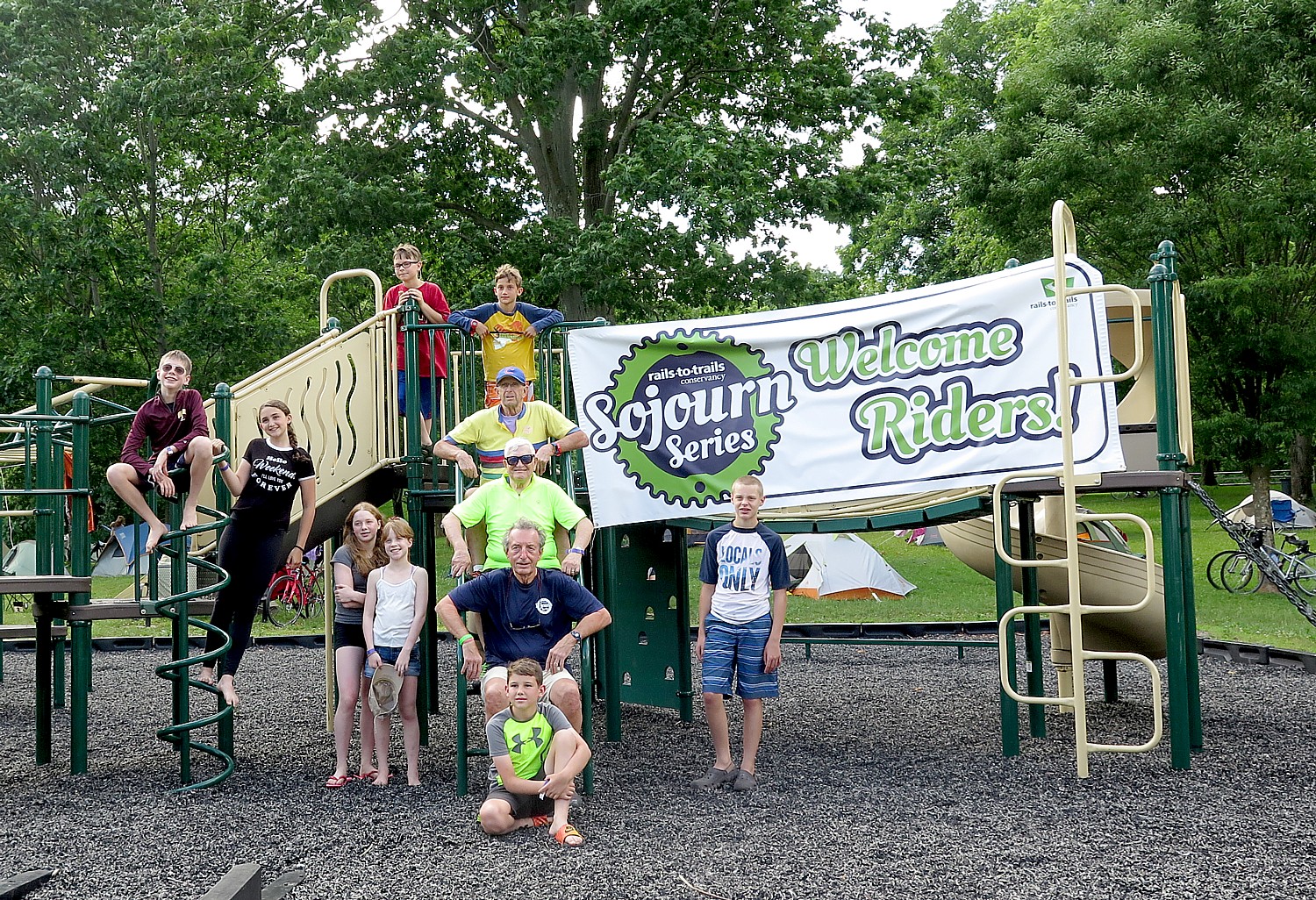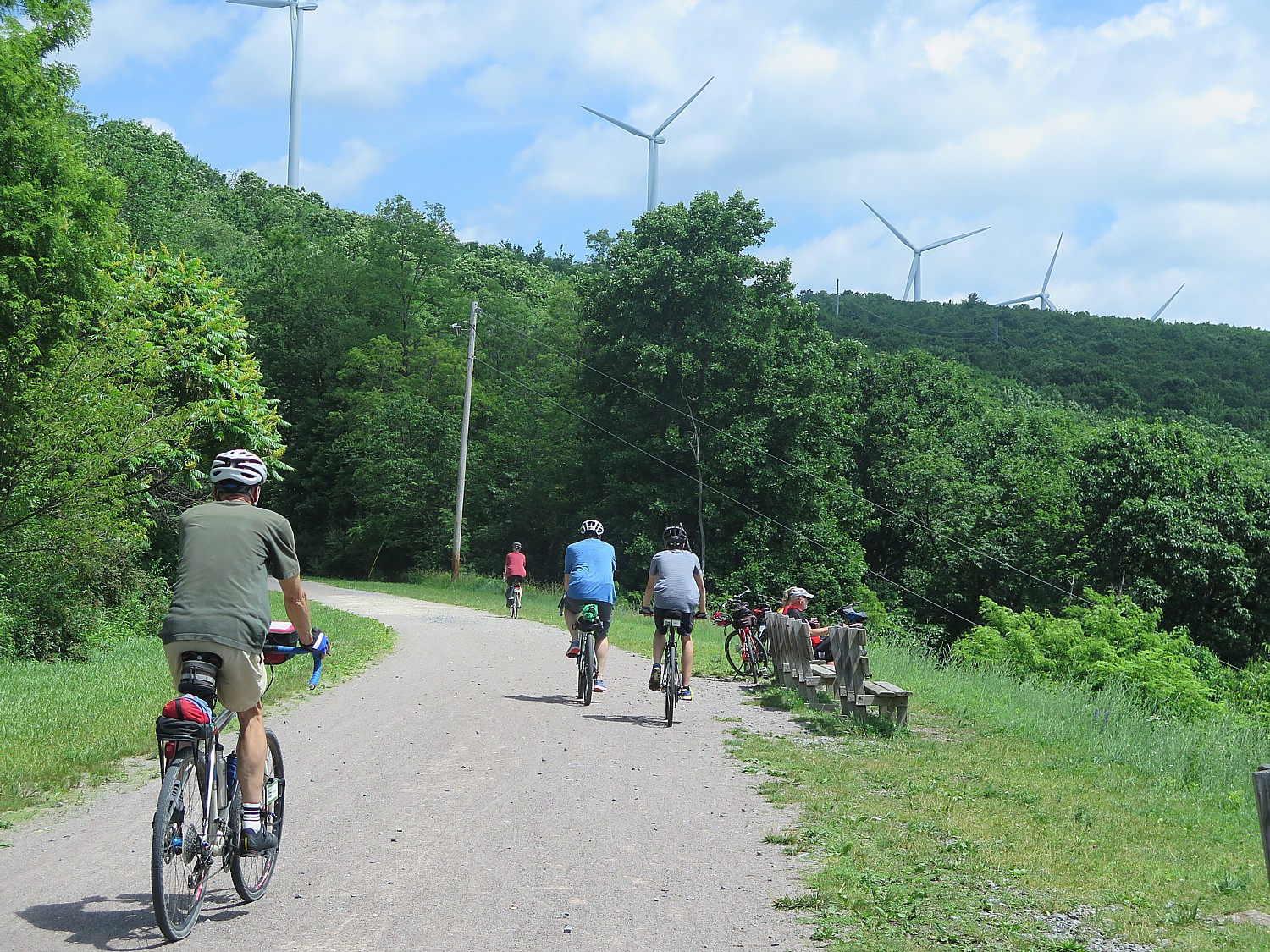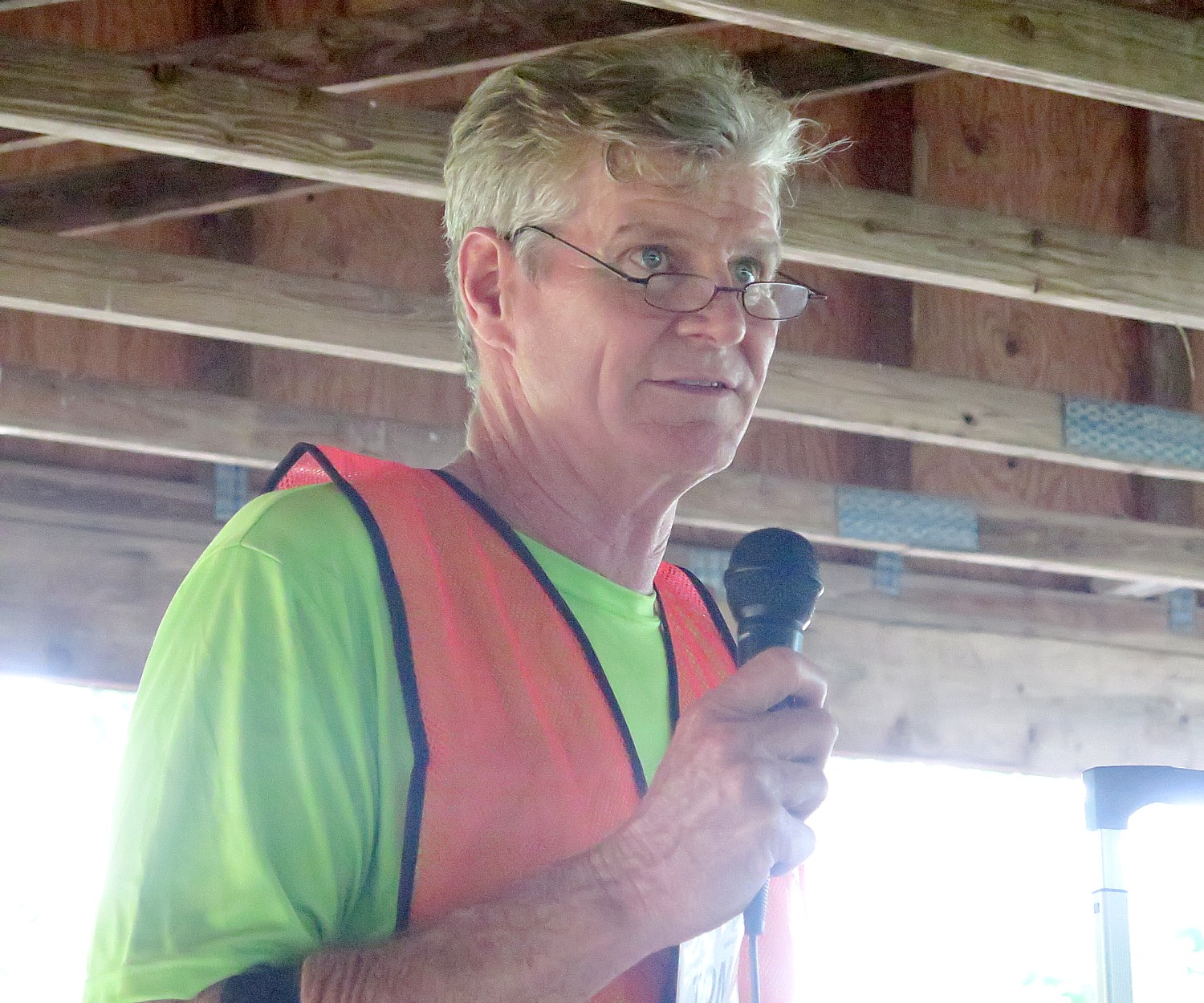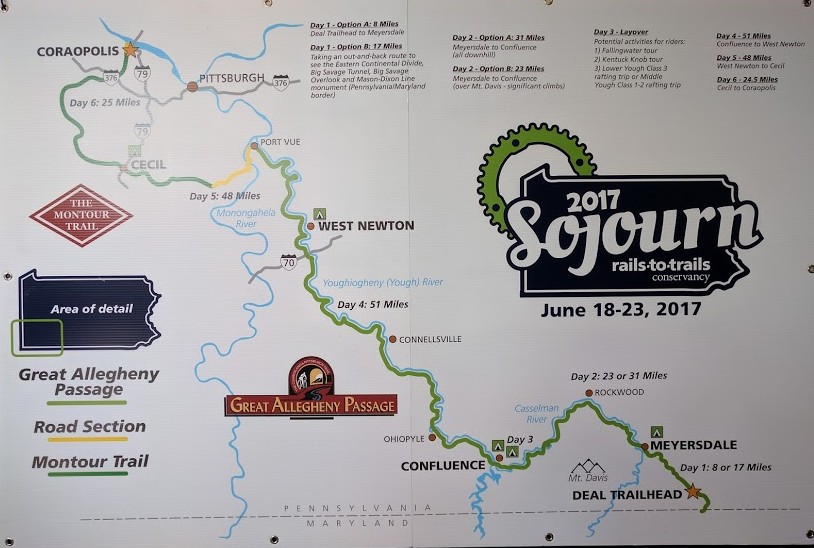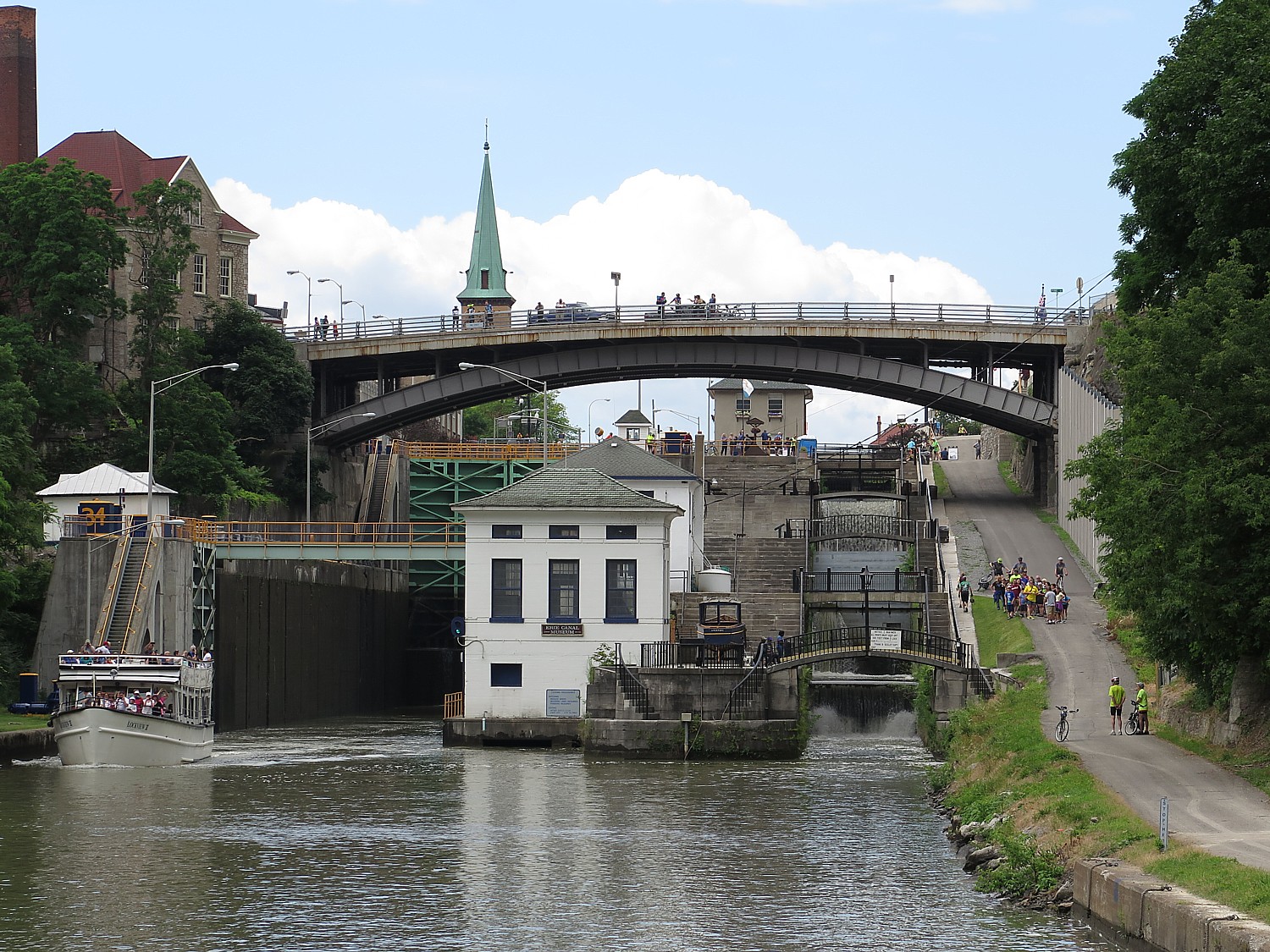
By Karen Rubin, Travel Features Syndicate, goingplacesfarandnear.com
Lockport is the best place of all to appreciate the engineering marvel of the Erie Canal and what the Canal meant to propelling the Industrial Revolution and the economy, ultimately establishing the United States as a global industrial power. And it is our first stop on our first day of our eight-day, 400-mile Cycle the Erie journey, an annual hosted ride offered by Parks & Trails NY, that takes us across New York State, from Buffalo to Albany, and with it, through 400 years of American history.
Here in Lockport, you not only see the only original part of the canal that is left – the famous “Flight of Five” locks in a short sequence – but they are literally adjacent to the modern Barge Canal and its only double-locks – two locks, one immediately after the another.
The 200-year old Flight of Five consecutive locks is the engineering marvel for its time which made the entire canal possible – finishing the distance to Lake Erie. Here at Lockport, the planners had the critical challenge of navigating the 60-foot elevation in the Niagara Escarpment. In these days before steel and electric motors, the wooden gates could only hold back the volume of water of a 12-foot drop.
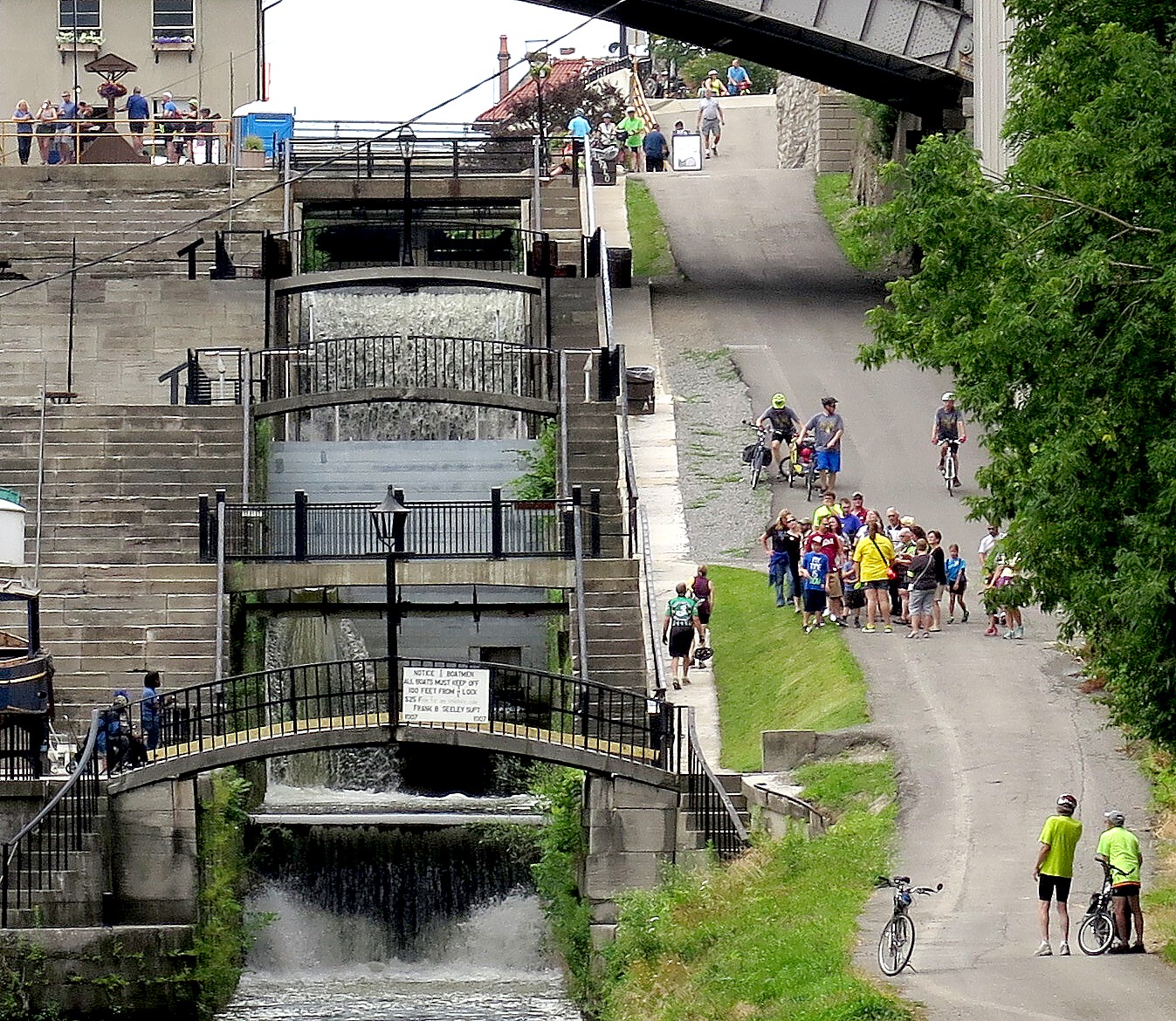
Amazingly, they didn’t figure out the solution before they committed to building the Canal and started digging in Rome, on July 4, 1817. This was deliberate: Rome is right at the center of the state where it is the flattest, where the Oneida Indians already had a crossing through the Appalachian Mountains. What is more, since the federal government had refused to provide any funding, New York State was funding the project on its own; Governor Dewitt Clinton felt there would be more likelihood of getting more funding from the state legislature if they had already started building). New York ultimately spent $7.7 million, the equivalent of $18 billion in today’s dollars.
“There were no civil engineers at that time. They had to invent their way across the state,” we are told in one of the evening lectures. (The telling of this story reminds me of the line in “Shakespeare in Love” to describe how everything would somehow work out: “It’s a mystery.”)
By 1822, 300 miles of the Erie Canal had already been dug. But to the west, the canal builders faced their most difficult challenge: the Niagara Escarpment was a 70-foot natural solid rock obstacle, the same mountain ridge over which Niagara Falls joins Lake Erie to Lake Ontario.
Nathan Roberts, who had no formal engineering training but had been working on the canal, came up with an innovative solution – still one of the most staggeringly unusual designs for its time: a series of five locks, each one raising or dropping a boat 12 feet. And because he knew it would consume a tremendous amount of time, he built two parallel steps of locks, so boats could go in both directions – an advancement in canal engineering.
“They had to build five levels of locks because each one could only go 12 feet. In the 1820s and 1840s, they didn’t have structural steel. The lock gates are wooden. ”
Even today, the “Flight of Five” locks are still admired as among the most extraordinary in the world. (We get to visit Nathan Roberts’ hometown, Canastota, much further down on the canal where there is a marvelous museum).
Indeed, like the 20th century space program, what was invented for the purpose of digging the canal became new techniques that could be applied elsewhere. The Erie Canal led to the founding of America’s first engineering school, Rensselaer Polytechnic Institute (RPI) in 1824, in Troy.
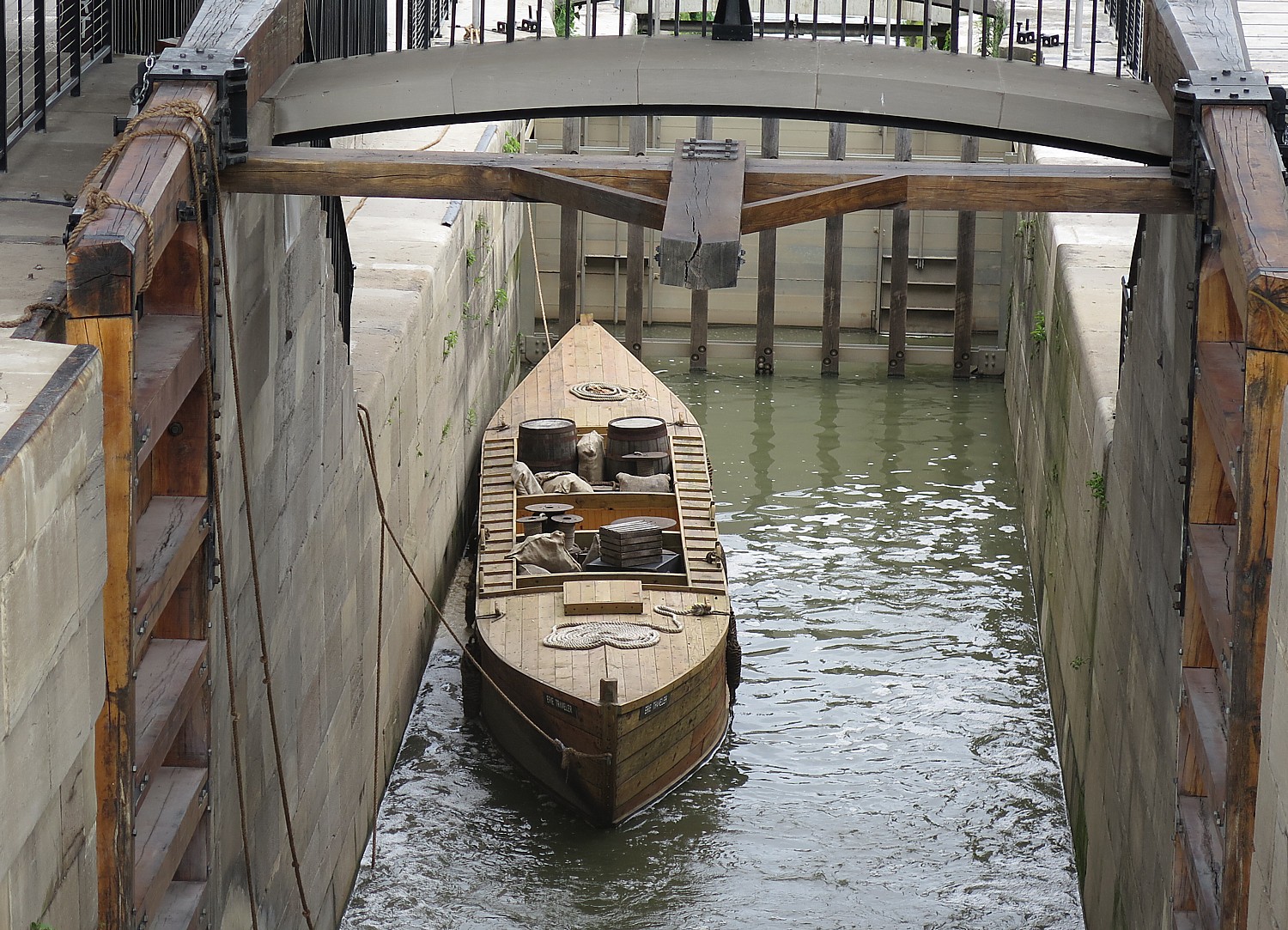
Here at Lockport, we get to see how the lock system worked. New York State has restored two of the original 19th century locks, and you can see how the wooden doors (a design that Leonardo Da Vinci had used) were opened manually using a large wood oar (they demonstrate this frequently during the day); the goal is to restore all five locks. The Buffalo Maritime Club built a replica wooden boat that is now in the lock. Here, you can see just how narrow the locks were. (New York State has funded the restoration of the other three locks.)
Indeed, this is the only place along the canal where you see the original and the modern canal locks in operation. And this is also the only set of modern double-locks on the Erie Canal, where boaters consecutively go from one to another.
Erie Canal Cruises
You especially appreciate this on the canal cruise that NY Parks & Trails, has arranged for the 750 cyclists who have joined the Cycle the Erie ride (a record number) on Erie Canal Cruises (210 Market St, 716-433-6155). I race through Lockport to get to the marina just in time for the 11 am cruise. It takes about an hour, and is really fun, especially as you go through the first lock and are spilled directly into the second.
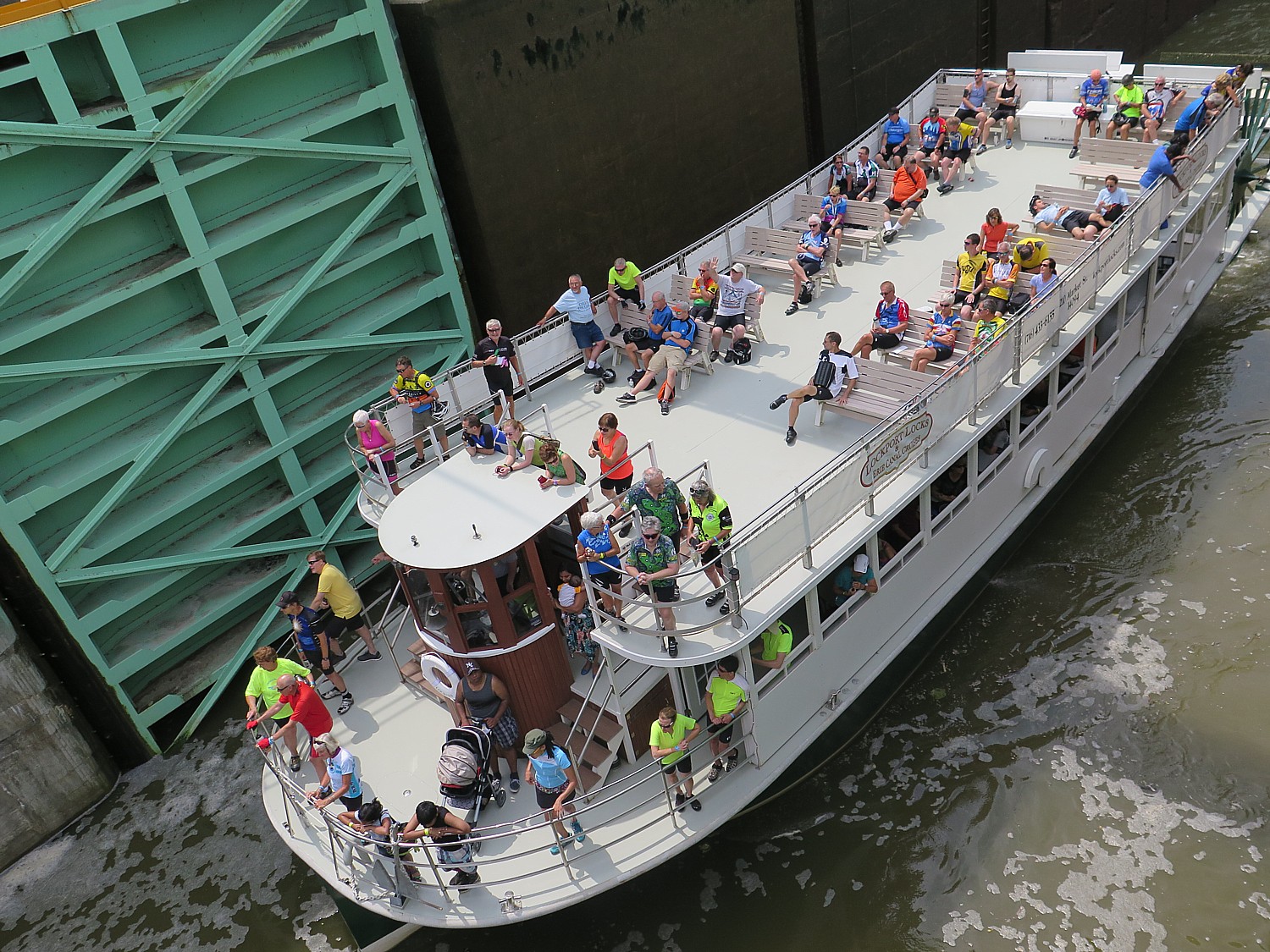
The first Erie Canal was 40 feet wide and just four feet deep, stretching 363 miles, from Albany-Buffalo, with 83 locks to take a boat the 565 feet in elevation. There were no motors involved, so a towpath was constructed along side, and mules, led by young boys known as “hoggies,” who walked 15 miles a day, pulled the canal boats along. One of these hoggies grew up to become president: James Garfield, Ben Willis of the Erie Canal Museum in Syracuse tells us at one of the evening lectures.
“The effect of the Canal was both immediate and dramatic, and settlers poured west. The explosion of trade prophesied by Governor Clinton began, spurred by freight rates from Buffalo to New York of $10 per ton by Canal, compared with $100 per ton by road. In 1829, there were 3,640 bushels of wheat transported down the Canal from Buffalo. By 1837 this figure had increased to 500,000 bushels; four years later it reached one million. In nine years, Canal tolls more than recouped the entire cost of construction. Within 15 years of the Canal’s opening, New York was the busiest port in America, moving tonnages greater than Boston, Baltimore and New Orleans combined,” according to the state’s canals website (www.canals.ny.gov/history/history.html)
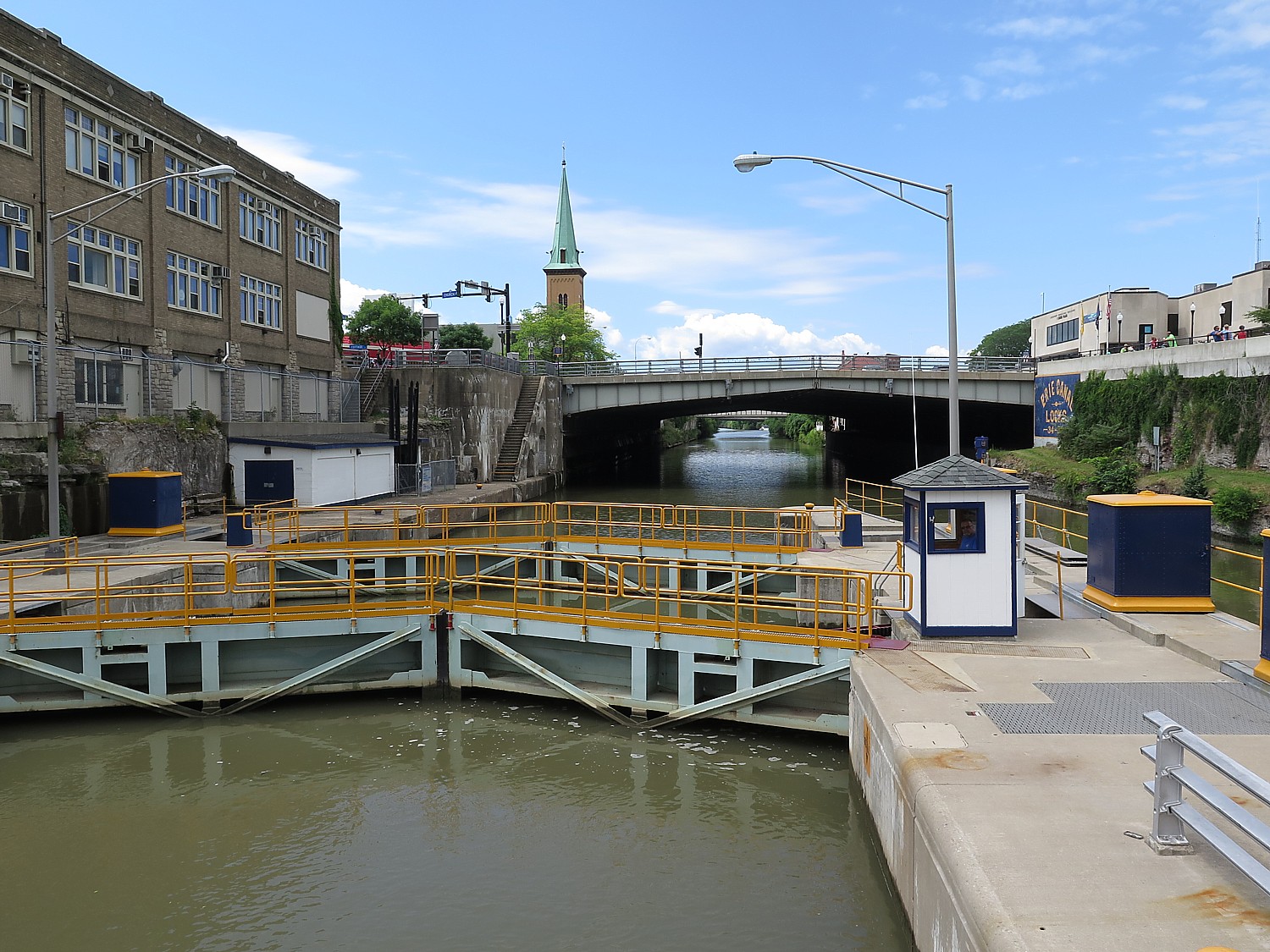
In order to keep pace with the growing demands of traffic, the Erie Canal was enlarged between 1836 and 1862. The “Enlarged Erie Canal” was 70 feet wide and 7 feet deep, and could handle boats carrying 240 tons. The number of locks was reduced to 72.
In 1898 Theodore Roosevelt, as Governor of New York, pushed to enlarge the canal again and straighten its route – in many cases relocating the canal altogether – to a width of 125 feet and minimum depth of twelve feet. The “modern” Barge Canal – the one we see today – was opened in 1918 and the motors which still open and close the lock doors are a century old, as well.

The cruise gives us a wonderful side-by-side view of the “modern” canal and locks (they still use the original GE motors which are 100 years old to open the large steel gates) against the original Clinton’s Ditch lock system, a town that was one of many along the route literally birthed by the Erie Canal. Only the gates are motorized; the rest is gravity.
Lockport offers insights into more than the extraordinary engineering of the Erie Canal: it is here where you get the clearest understanding of how the canal spurred the Industrial Revolution, and made the United States a manufacturing and global power. By 1830, Lockport had grown to the size of Buffalo and Rochester but was eclipsed after Civil War.
Lockport Cave & Underground Boat Ride
You really appreciate this when you take the Lockport Cave & Underground Boat Ride, which I did on my first Cycle the Erie trip (absolutely fascinating and I have to believe is fairly unique; Cycle the Erie riders get a discount with our wristband).
Up on the hill above the canal were a string of factories. Before Tesla and Edison, engines used water power which was abundant in Lockport. Birdsell Holly, who had a three-story factory, Holly Manufacturing Company, devised a water “raceway” to power the factory –which involved digging a tunnel to capture the seemingly unlimited flow of water.
Our walking tour starts on the canal, where our tour guide, relates the history. Then we walk down a slope to where the hillside means the canal, passed where there would have been three factories.
We walk passed where there would have been a three-story factory, the Holly Manufacturing Company.
“Birdsill Holly, the owner, was famous in his day. He had 150 patents, second-most to Thomas Edison” who was a friend and who asked Holly to join him at his lab in Menlo Park, but Holly wanted to stay on his own. He was a genius at mechanical engineering and specialized in hydro-mechanical systems.” He also created the system of using the rushing water through tunnel (a hydraulic “raceway”) to power turbines.
Among Holly’s inventions: the rotary water pump, the Silsby steam fire engine, the fire hydrant (he actually reminds me a lot of Ben Franklin). Holly had the idea to build a 19-story skyscraper with a view of Niagara Falls, which he expected to become a popular tourist attraction, but never raised the financing.
Holly, who was born in 1820, came to Lockport from Seneca Falls in 1851. He opened the Holly Manufacturing Company in 1859 to produce sewing machines, cistern pumps and rotary pumps. Holly built the Lockport Fire Protection and Water System in 1863, which used pumps powered by water-turbines and steam-engines to bring water to hydrants in the city. He patented a fire hydrant in 1869, manufactured in his factory.
At its peak, the factory employed 500 people. Ironically, his factory was destroyed by fire in 1909 (there is a photo of the fire hanging in the tour office).
Next, we walk passed where the Richmond Factory, founded in 1868, would have been – portions of gatehouse can still be seen. It utilized Holly’s hydromechanical system. But in 1993, it too, was destroyed by fire.
The third was the Lockport Pulp factory, which operated from1880-1941, when it went out of business after the invention of galvanized steel. “Their lease ran out in 1941 and they lost the use of the water.”
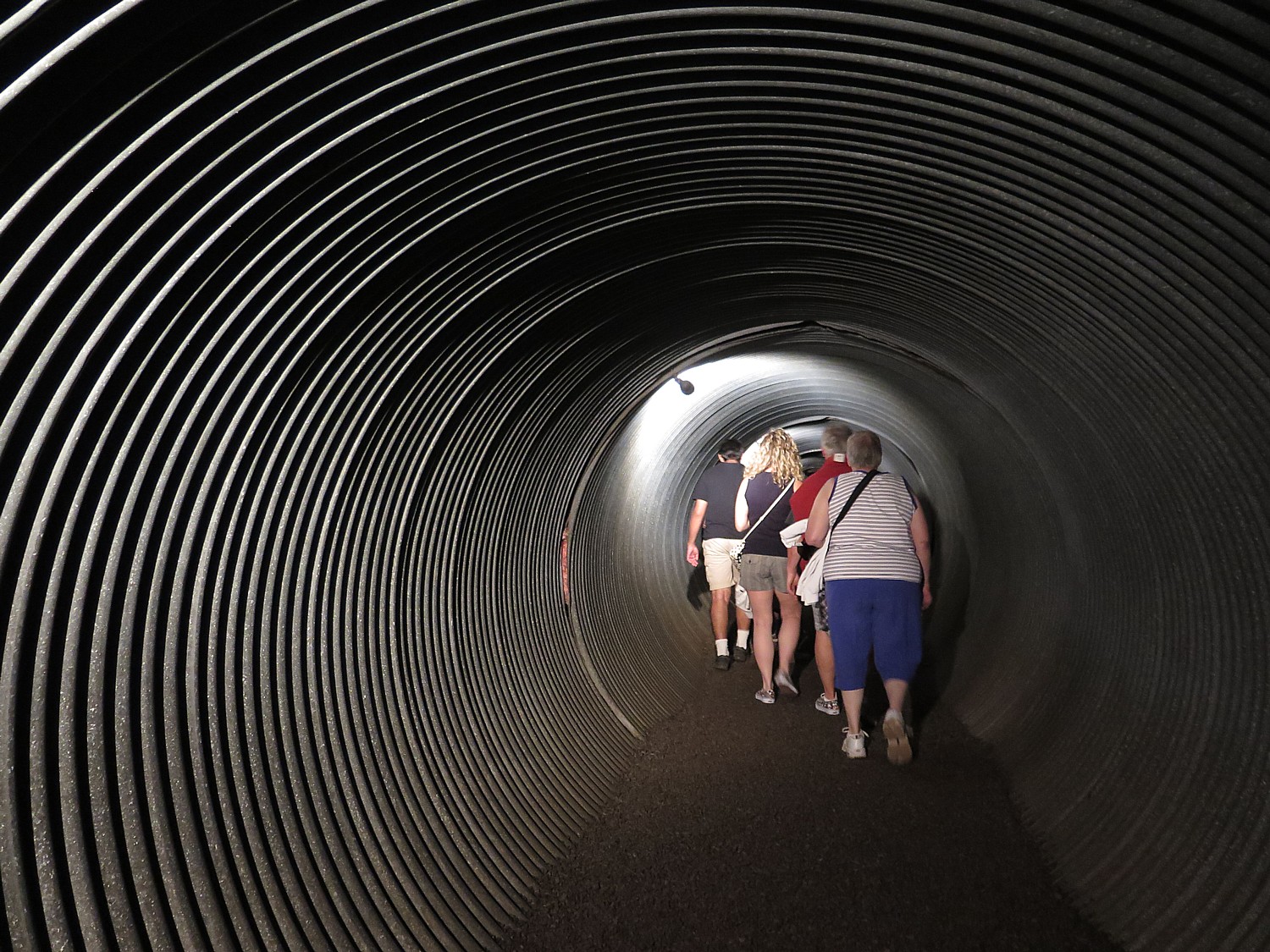
We come to a great outflow pipe which we use as our entrance into the cave, which once would have been the “raceway” for the rushing water.
This is the system devised by the privately owned Hydraulic Raceway Company (Birdsill Holly was a major investor) to serve his factory and the others.
It is quite an interesting sight – pitch black except for the artificial light.
The tunnel was cut by Irish and Italian workers. Our guide points out what would have been involved in digging out this tunnel and creating the cave, using the technology they had – sledgehammers and black powder. “They worked long hours doing dangerous work for low wages.” At one point, they went on a labor strike.
Boys as young as five years old would be the ones to plant the dynamite because they were small and fast. Each charge would blast a hole the size of a basketball. There are no statistics as to how many boys or men died building these tunnels.
Holly built his tunnel first, in 1858. It took 1 1/2 years to dig 750 feet. Richer opened his factory in 1868. A third section was opened eight years later, taking three years, until 1880 to finish. The factories would have paid $200 year for access to water.
Now our walk takes us to a wooden boat, built inside the cavern. “Welcome aboard Titanic 2,” the guide, jokes.

It is very “Phantom of the Opera”-ish, but here, you really appreciate the physical labor that was involved in cutting through rock to create these mechanisms that made the Industrial Revolution factories possible.
It is really a delightful boat-ride, full of atmosphere, that takes us through the oldest section of the tunnel. You can see some differences in how it was constructed. We can appreciate how long it takes to form a stalactite by how small these are. We see soda stalactites (they have a hollow interior).
($13 plus tax, but $9 for Erie Canal riders. Lockport Cave & Underground Boat Ride on the Erie Canal, (5 Gooding St., 716-438-0174, www.lockportcave.com).
There is a lot to see in Lockport, including the Erie Canal Discovery Center, a small museum right at the base of the original five locks, which I visited on my first Cycle the Erie ride; Tiffany windows at the First Presbyterian Church, the Historic Palace Theater, and delightful eateries (www.discoverlockport.com).
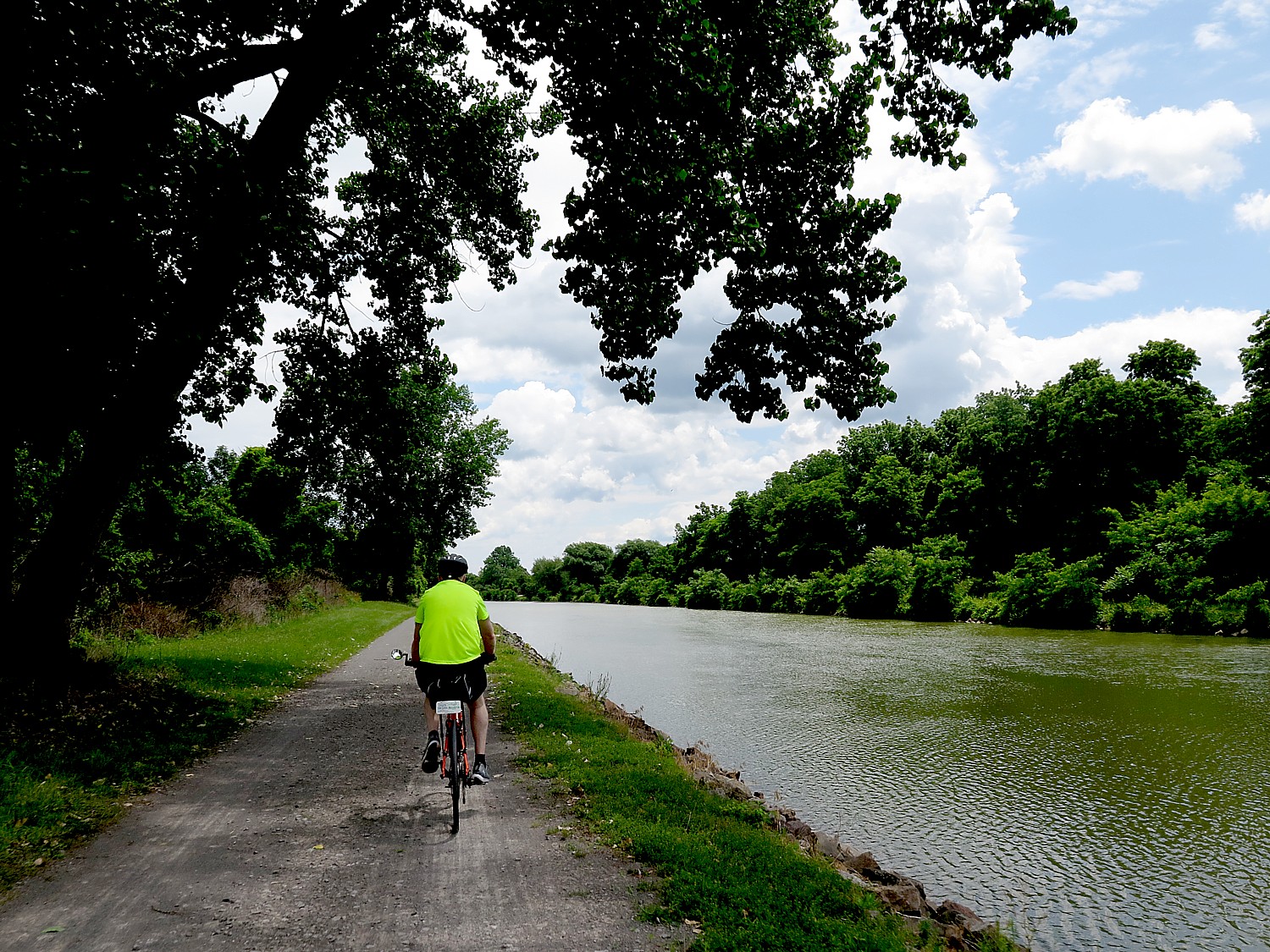
I am anxious to get to Medina, though, which I remember from my first Cycle the Erie ride as being a really charming town (they even have a concert planned for the afternoon, and swimming at our campsite), and last time, I didn’t get there early enough to enjoy it.
We ride through a sequence of quaint canaltowns, Gasport, Middleport, – on our way to Medina.
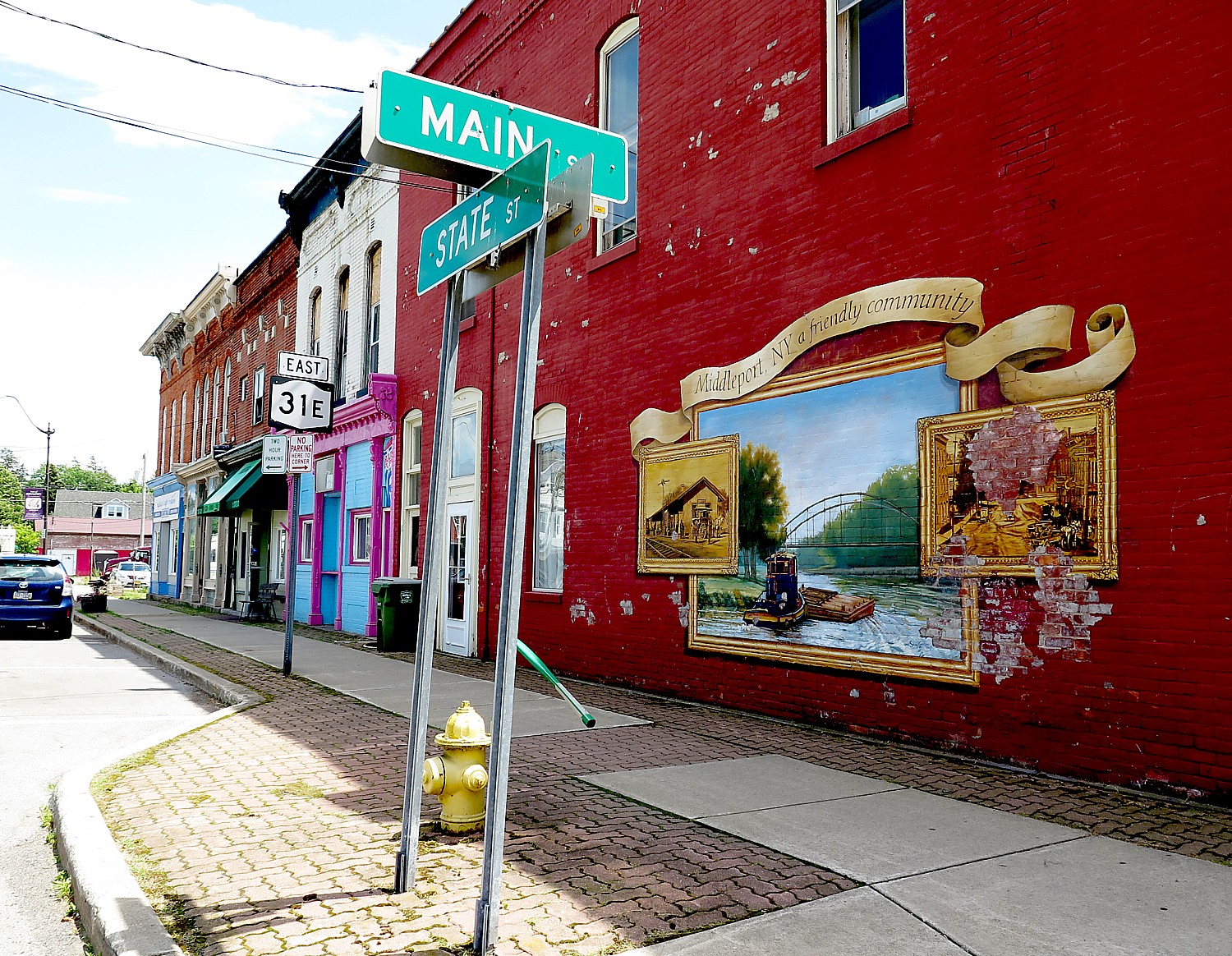
Medina is famous for its sandstone, a 19th century building material that was used for the base of the Brooklyn Bridge, the State House in Albany, St. Paul’s Episcopal in Albany and in the foundation of Buckingham Palace. The stones, discovered during the building of the canal, were prized because they were so hard, they were the best for fireproof building material.

Much of Medina is built of the stone. You see it at one of America’s oldest Opera Houses (it is being restored) – a tribute to the wealth that the stone and the Erie Canal brought,.
I arrive in Medina, our destination for the day, at around 2:30 pm, in time to catch a delightful folk concert at the canalside park. The band, Traveling Troubadours, perform on the roof of a rented houseboat. Wearing tie-die, the aging hippies will be spending 6 days, going canaltown to canaltown to perform.
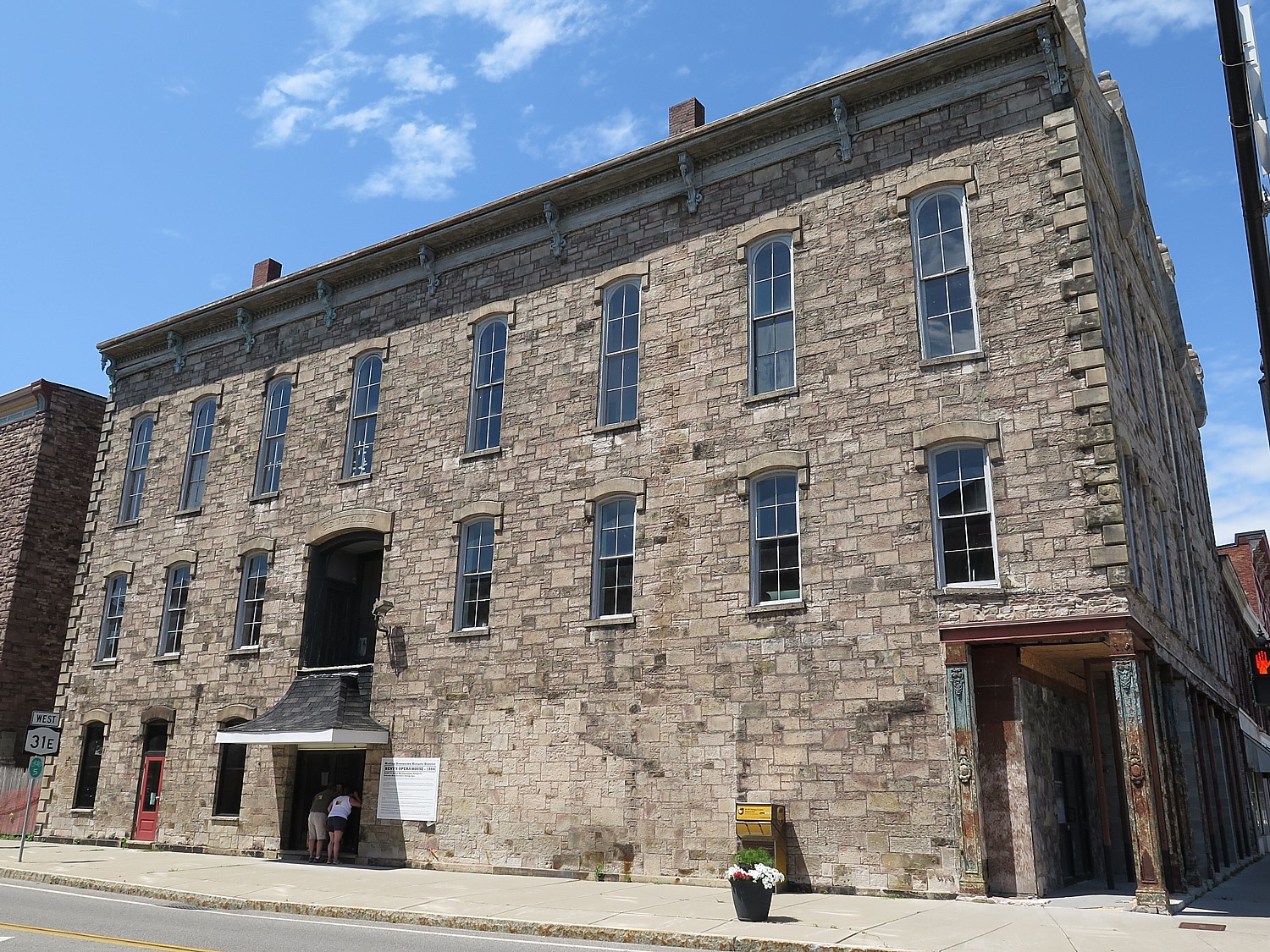
I must have had a tailwind because the 54 miles of biking today didn’t feel like it at all.
The architecture is absolutely magnificent – and our ride to the campground takes us through neighborhoods with gorgeous, but fading, Victorian houses.
On the way into the campsite, I stop at Medina Railroad Museum – housed in the former New York Central Freight Depot. Built in 1905-6, and 300 feet long, it is the longest wood frame freight house ever built by NYC Systems. There are over 7,000 artifacts on display covering the history of railroads from the early steam era up to the modern age. Exhibits feature vintage toy trains from Lionel, Marx and American Flyer, as well as extensive firefighting exhibit with 460 fire helmets. The HO model train layout is one of the longest on one floor in the country, measuring 204 feet long by 14 feet wide, and featuring lifelike scenery of Western New York. The museum also offers excursions on vintage trains. (530 West Ave., Medina 585-798-6106, MedinaRailroad.com)

As I set up my tent at the beautiful grounds of the Clifford H. Wise Middle School, I think how we have gone from an urban to a pastoral setting. They have arranged for us to swim in the school’s pool, as well as stretching class and yoga and there is a massage therapist as well. This evening after dinner, there is a talk about canal history by Tom Grasso, president of the NYS Canal Society.
The 20th Annual Cycle the Erie Canal ride is scheduled July 8 – 15, 2018 (www.ptny.org/canaltour). In the meantime, you can cycle the trail on your own – detailed info and interactive map is at the ptny.org site (www.ptny.org/bikecanal), including suggested lodgings. For more information on Cycle the Erie Canal, contact Parks & Trails New York at 518-434-1583 or visit www.ptny.org.
Information is also available from the Erie Canalway National Heritage Corridor, Waterford, NY 12188, 518-237-7000, www.eriecanalway.org.
More information about traveling on the Erie Canal is available from New York State Canal Corporation, www.canals.ny.gov.
Next: Cycle the Erie, Day 2: Medina to Fairport, 53 miles
See also:
Cycle the Erie: 400 Miles & 400 Years of History Flow By on Canalway Bike Tour Across New York State
_____________________________
© 2018 Travel Features Syndicate, a division of Workstyles, Inc. All rights reserved. Visit goingplacesfarandnear.com, www.huffingtonpost.com/author/karen-rubin , and travelwritersmagazine.com/TravelFeaturesSyndicate/. Blogging at goingplacesnearandfar.wordpress.com and moralcompasstravel.info. Send comments or questions to [email protected]. Tweet @TravelFeatures. ‘Like’ us at facebook.com/NewsPhotoFeatures

